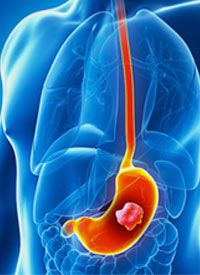Surgical Palliation Enables Solid Food Intake in Advanced Incurable Gastric Cancer
Surgical palliation in patients treated for malignant gastric outlet obstruction maintains quality of life and improves solid food intake for at least 3 months after surgery.

Surgical palliation in patients treated for malignant gastric outlet obstruction maintains quality of life (QOL) and improves solid food intake for at least 3 months after surgery, according to data presented at the 2017 Gastrointestinal Cancers Symposium in San Francisco. The multicenter observational study also indicated that about three fourths of patients could tolerate solid foods at 3 months postsurgical follow-up, when at baseline no patient could tolerate solid food.
“To the best of our knowledge, this is the first prospective multicenter observational study of surgical palliation examining postoperative QOL in patients with malignant gastric outlet obstruction caused by incurable advanced gastric cancer,” said Kazumasa Fujitani, MD, Osaka Prefectural General Medical Center in Osaka, Japan, who presented the data. “This study provides the largest sample size of QOL data for this setting.” The improvement in solid food intake and the maintenance of QOL were achieved with acceptable surgical toxicity, he added.
The prognosis of patients with incurable advanced gastric cancer is dismal. Chemotherapy is the standard of care, but two types of surgical intervention exists for such patients: 1) reductive gastrectomy in asymptomatic patients, which has failed to show a survival benefit when followed by chemotherapy compared with chemotherapy alone, and 2) palliative resection or bypass surgery in the presence of serious symptoms.
Researchers examined 104 patients with no or extremely poor oral intake requiring parenteral nutrition.Patients underwent either palliative distal/total gastrectomy (DG/TG) or gastrojejunostomy (GJS), at the discretion of the physician. Patients were assessed clinically at baseline, 2 weeks, 1 month, and 3 months using validated QOL instruments—the EORTC QLQ-STO22, a gastric cancer-specific instrument, and the EuroQol-5D, a general health status instrument—and the gastric outlet obstruction scoring system (GOOSS), which measures oral intake on a scale of 0 (no oral intake) to 3 (low residues or full diet).
Of the 104 patients, 71 were male and 33 were female. Their median age was 68 years. Seventy-five patients had 2 or more non-curable factors. Eighty-eight patients had an ECOG performance status of 0 or 1. Seventy patients underwent GJS, 23 had distal gastrectomy, 9 had total gastrectomy, and 2 underwent exploratory laparotomy. Seventy-seven patients completed the surveys at all assessment time points; 16 patients died and 11 had missing data at some time points. Compliance with the health instrument questionnaires was approximately the same in patients undergoing gastrectomy and those undergoing GJS.
The mean baseline EQ-5D score was 0.74, a score that remained consistent throughout the 3-month follow-up, with the difference from baseline being 0.05. QOL consistency of baseline scores was evident with both types of procedures. A slightly higher percentage of patients had deteriorated scores on the EQ-5D or died or had missing data compared with improved or stable scores, which was true of both types of surgeries. In multivariate analysis, only male gender was independently associated with improved or stable QO scores 3 months after surgery (P = 0.031).
The QLQ-ST022 components dysphagia, reflux, eating restrictions, pain, and anxiety all showed significant improvement. Scores for the taste and dry mouth items were not altered.
“No patient could tolerate solid food at baseline, but at 2 weeks postsurgery, 80% of [patients] came to eat solid food, and it remained tolerable thereafter,” said Fujitani. Solid food intake was possible in 82 patients at 2 weeks, 85 at 1 month, and 75 at 3 months. A higher percentage of patients were able to eat postgastrectomy at all assessment time points compared with those undergoing GJS, but this difference was not significant. On multivariate analysis, male gender (P=0.007) and baseline albumin level ≥3.5 (P = 0.006) were predictive factors for improved oral intake (a GOOSS of 3) at 3 months postsurgery.
The study “is incredibly important,” said invited discussant Mitchell C. Posner, MD, from the University of Chicago. “Most of the patients in this study underwent a simple bypass procedure and a lesser percentage underwent some form of gastrectomy.” An important question the study raises is whether the same result can be achieved with an endoscopic stent to avoid surgery altogether a means of palliation.
Fujitani K, Ando M, Sakamaki K, et al. A prospective multicenter observational study of surgical palliation examining postoperative quality of life in patients treated for malignant gastric outlet obstruction caused by incurable advanced gastric cancer. Presented at: 2017 Gastrointestinal Cancers Symposium; January 19-21, 2017; San Francisco, CA. Abstract 6.
<<<
View more from the 2017 GI Cancers Symposium
Postoperative complications occurred in 25 patients, and the overall morbidity rate of ≥grade 3 on Clavien-Dindo classification was 9.6%. Reoperation was necessary in 2 patients, 1 due to abdominal abscess 10 days after GJS and one due to duodenal stump leakage 13 days after gastrectomy. Six patients died in the hospital or within 30 days postoperatively, all of which were attributed to disease progression.



